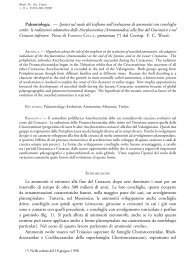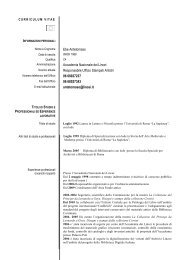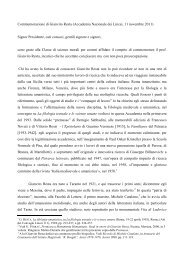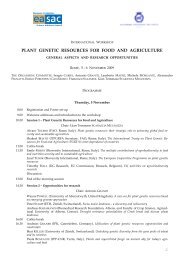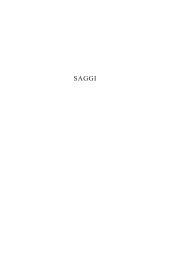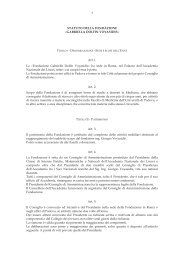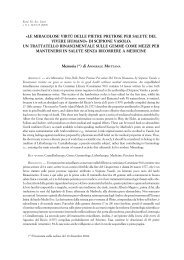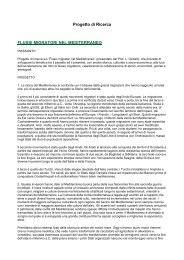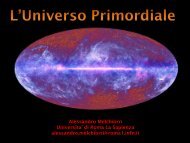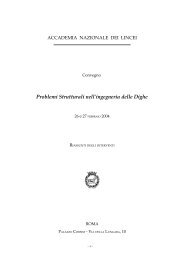Bollettino dei Classici - Accademia Nazionale dei Lincei
Bollettino dei Classici - Accademia Nazionale dei Lincei
Bollettino dei Classici - Accademia Nazionale dei Lincei
You also want an ePaper? Increase the reach of your titles
YUMPU automatically turns print PDFs into web optimized ePapers that Google loves.
11<br />
I. (M. T. Luzzatto): In this paper I argue, against generally held views, that PBerol.9780r. is a fragment from Book<br />
28 of Didymus's lucidly organized commentary on the whole corpus of Demosthenes, in its original format.<br />
Apparent gaps in the coverage of Philippics 10-13 are neither the result of excerption nor of negligence on the<br />
author's part, but reflect the re-use of the same topics and passages from one speech to another, which was a well-<br />
known feature of the Philippics. Didymus skips doublets (maybe following critical signs in his edition of the orator),<br />
and his very professional commentary obviously shrinks as it approaches the end. A detailed discussion of (a)<br />
Didymus fragments in Harpocration, (b) the order of speeches in ancient editions of Demosthenes, (c) the colophon<br />
in col. 15 demonstrates that PBerol. is the final part of Didymus's huge commentary on the orator, and refutes F.<br />
Leo's interpretation of the work as a historical syngramma about Demosthenes, casting serious doubts on the so-<br />
called Peri-literature as a whole.<br />
II. (T. Raiola): By the means of a reexamination of the manuscript tradition of the galenic commentary to<br />
Hippocrates' De Officina medici, this paper proposes to reconsider the incipit of the third book of the commentary<br />
itself, as it is printed in modern editions since the princeps. A strong evidence supporting the author's hypothesis is<br />
given by the arabic compendium of Ali ibn Ridwan, written in the XI th century A. D., whose third section starts with<br />
the same sentence recognised here as the real incipit of the third book.<br />
III. (A. Tessier): The first verse of the parodos of Euripides’ Orestes (140) is handed down to us in the ms. tradition<br />
with a slight variant reading, which nonetheless affects the metrical responsion of the strophe and has been therefore<br />
exposed to editorial assaults from the Paleologan age onwards. This paper aims to delve into the question, reexamining<br />
the different steps of the ecdotic practice on the tragic text: to this purpose new evidence is taken into<br />
account, drawn from the well-known quotation of the Euripidean verses offered by Dionysius of Halicarnassus in<br />
his De compositione verborum.<br />
IV. (P. Janni): I. In several notable passages of ancient poetry, since Hesiod’s Theogony, Dawn (more or less<br />
personified) appears as a source of light independent from Sun, sometimes even more important than he. She is the<br />
real bearer of the day, and the sun comes later, when night is already driven out and the world is fully enlightened by<br />
Eos. Very often, the ancient authors speak as if the light of the sun were a matter, and the light of dawn another one,<br />
quite different. Just an example among many others: Ovid’s Medea, to spread magically darkness on the earth,<br />
extinguishes three sources of light: sun, moon and dawn. A near parallel is to be found in the Vedic hymns of<br />
ancient India, where the goddes of dawn is the real maker of the day, worshipped as the light of the world. II.<br />
According to a kindred conception, this too well represented in ancient literatures, both poetical and philosophical,<br />
light is an element for itself, diffused everywhere in the All, and the sun, far from being the all-important source of<br />
it, is just its most apparent manifestation. The day is the luminous half of the revolving celestial sphere, not the effect<br />
of the sun being above the horizon, which is just an accompanying phenomenon. Night, on its side, is not simply the<br />
withdrawal of light, but the positive arrival of the dark element. In other words, the day doesn’t appear because the<br />
sun rises; rather, the day appears and the sun rises. All that is not unknown to belief and mythology of other cultures:<br />
the God of Genesis too creates light before the sun and the stars.<br />
V. (P. D'Alessandro): Varro certainly composed phalaecians (Men. frr. 565-568 B[ücheler], from Virgula divina; fr.<br />
49 B., from Bimarcus, might be a trochaic septenarius) and regarded the phalaecian as an ionic trimeter. As a<br />
phalaecian Röper interpreted fr. 101 B. and Della Corte both fr. 101 and fr. 19. Bücheler, on the contrary, ascribed<br />
frr. 19, 87, 101 (dubitatively), 489 and perhaps 579 to systems of continuous ionics a maiore as well as a minore (fr.<br />
579): he compared them with Lev. fr. 49 Blänsdorf, from Phoenix (two verses, both undoubtedly ionics a maiore,<br />
according to Müller’s opinion; Leo wrongly unterstood the first verse as an ionic a minore); since Levius’ Phoenix<br />
is a carmen figuratum, Bücheler also supposed that fr. 489 comes from a carmen figuratum. This fragment,<br />
however, is too corrupt and it’s impossible to reconstruct its metrical form. Fr. 579 is an Augustinus’ exemplum<br />
fictum, erroneously attribuited to Varro. Frr. 19, 87 and 101 finally must be considered sotadeans.<br />
***




